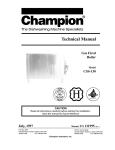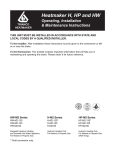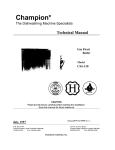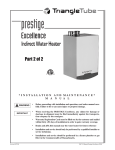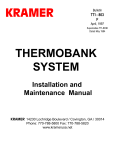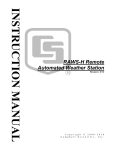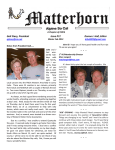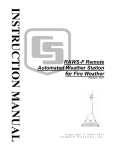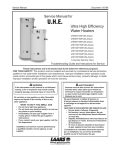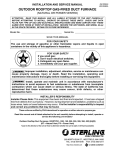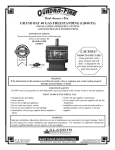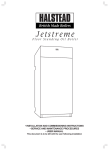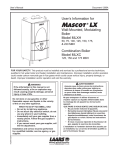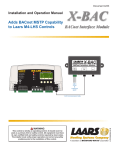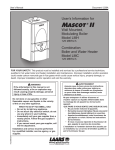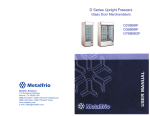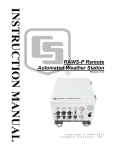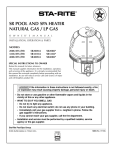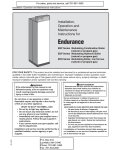Download 9600 CB & HWG
Transcript
Service Manual Document 2109 Service Manual for 9600 CB & HWG HWG-M2 Series HWG-M2-250 HWG-M2-200 HWG-M2-175 HWG-M2-150 Hot Water Generator For Natural or Propane Gas CB-M2 Series CB-M2-250 CB-M2-200 CB-M2-175 CB-M2-150 Condensing Boiler For Natural or Propane Gas FOR YOUR SAFETY: This product must be installed and serviced by a professional service technician, qualified in hot water boiler installation and maintenance. Improper installation and/or operation could create carbon monoxide gas in flue gases which could cause serious injury, property damage, or death. Improper installation and/or operation will void the warranty. WARNING If the information in this manual is not followed exactly, a fire or explosion may result causing property damage, personal injury or loss of life. Do not store or use gasoline or other flammable vapors and liquids in the vicinity of this or any other appliance. WHAT TO DO IF YOU SMELL GAS • Do not try to light any appliance. • Do not touch any electrical switch; do not use any phone in your building. • Immediately call your gas supplier from a nearby phone. Follow the gas supplier's instructions. • If you cannot reach your gas supplier, call the fire department. Installation and service must be performed by a qualified installer, service agency, or gas supplier. LAARS Heating Systems Page 2 TABLE OF CONTENTS SECTION 1. General Information 1A. 1B. 1C. 1D. 1E. 1F. 1G. 1H. 1I. 1J. 1K. 1L. 1M. 1N. Introduction ................................................... 3 Start Up Procedures ..................................... 9 Checkout Procedures ................................... 9 Cleaning the Combustion Chamber Coil .... 10 Diverting Valve ........................................... 10 Safety Limit Switch ..................................... 10 Boiler Control .............................................. 10 Stack Switch ............................................... 11 Igniter .......................................................... 11 Transformer ................................................. 11 Unit Pump ................................................... 11 Blower ......................................................... 11 Gas Valve ................................................... 11 Time Delay Relay (TDR) .............................. 11 1O. 1P. 1Q. 1R. 1S. 1T. 1U. 1V. 1W. 1X. 1Y. Operating Control ........................................ 11 Vent TCO .................................................... 12 Intake TCO .................................................. 12 Thermal Cut-Out (TCO) ................................ 12 Delayed Ignition ........................................... 12 High Gas Consumption ............................... 12 Noisy Operation .......................................... 12 Short Cycling .............................................. 13 Lock Outs (& Trip Outs) .............................. 13 Routine De-Liming Procedure ...................... 14 Sequence of Operation ................................ 14 SECTION 2. Troubleshooting 2A. Code ........................................................... 15 9600 CB & HWG Service Manual SECTION 1. General Information 1A. Introduction The Heatmaker 9600 CB condensing boilers and the Heatmaker 9600 HWG non-automatic circulating tank water heaters have a dual heat exchanger (H-X) design. The primary H-X is a copper coil type which operates in a non-condensing mode. A secondary stainless steel H-X (economizer) surrounds the primary H-X to condense water vapor from the flue gases and extract the maximum amount of heat from the combustion process. Condensate from the economizer drains into the bottom of the outer shroud of the boiler section and into the exhaust duct which provides for condensate drainage. Flow rates through the primary H-X are controlled by a thermostatic diverting valve which diverts water, as required, from the outlet of the Figure 1. Heatmaker 9600 Assembly View. Page 3 primary H-X back to its inlet so that the primary H-X temperature is always maintained above the condensation temperature of the water vapor in the flue gases. A circulator is built into the unit to provide enough head to circulate water through the H-X’s and to a secondary heating loop or separate hot water storage tank. The forced draft premixed combustion system contains a blower to provide air flow through the unit, the air inlet and exhaust piping. The cylindrical burner is provided with an air/gas mixture which is metered through fixed orifices. A hot surface igniter (glow coil) is controlled by the Integrated Boiler Control which also controls the blower, circulator, and gas valve and provides for burner flame safety. The Heatmaker 9600 is designed to use 3" PVC* or ABS DWV pipe or PVC, ABS or CPVC schedule 40 pipe for both air intake and flue material. Vent terminations are provided with the unit. * CB / HWG - M2- 250 flue material can only be ABS or CPVC. (1) Diverting valve (2) Circulator (3) Mixer tube (4) Exhaust (5) Blower (6) Gas valve (7) Burner (8) Economizer (9) Combustion coil (10) Cold water inlet (11) Hot water outlet (12) Heat exchanger drain (13) Air vent LAARS Heating Systems Page 4 A PORTION OF HOT WATER IS RECYCLED TO MAINTAIN COMBUSTION COIL INLET TEMPERATURE AT 140°F THERMOSTATIC DIVERTING VALVE (160° F THERMOSTAT) (E) (D) (B) (A) COMBUSTION COIL ECONOMIZER (A) Cold Water Inlet From Tank or System (B) Economizer Outlet (10°F Rise above inlet) (C) Combustion Coil Inlet 130-140°F Typical (D) Combustion Coil Outlet (E) Hot Water Outlet To Tank or System 160 - 170°F Typical Figure 2a. Water Flow through a Heatmaker 9600. HWG - Before S/N 394 - 068 CB - Before S/N 795 - 0014 9600 CB & HWG Service Manual Page 5 1 2 3 4 5 6 7 8 9 10 11 12 A B C D Figure 2b. Water Flow through a Heatmaker 9600. HWG - After S/N 394 - 067 CB - After S/N 795 - 0013 Legend Mixing Valve Internal Pump Mixer Tube Flue Outlet Combustion Fan Air Pressure Switch Burner Secondary Heat Exchanger Primary Heat Exchanger Return (From Primary Loop) Gas Valve Flow (To Primary Loop) Secondary Heat Exchanger Inlet Secondary Heat Exchanger Outlet Primary Heat Exchanger Inlet Primary Heat Exchanger Outlet LAARS Heating Systems Page 6 EXHAUST INTAKE TERMINAL 43 WALL PLATE 50 EXHAUST TERMINAL AIR INTAKE 44 WALL PLATE 45 AIR ORIFICE GAS ORIFICE 1 2 COMBUSTION COIL GAS ECONOMIZER 7 FLAMEHOLDER 46 REFERENCE PAGE 8 FOR PART NUMBERS Figure 3. Air/Fuel Flow Through Heatmaker 9600. EXHAUST ASSEMBLY CONDENSATE 9600 CB & HWG Service Manual Figure 4. Cut Away View of Heatmaker 9600. Figure 5. Control Box. Page 7 LAARS Heating Systems Page 8 32 HIGH LIMIT SAFETY SWITCH BOX 31 38 OPERATING LIMIT CIRCULATOR PUMP CONTROL BOX SUB-ASSY HEATMAKER 9600 BLOWER ASSEMBLY 16 BLOCKED FLUE DETECTOR 30 IGNITER ASSY 6 GAS VALVE 36 VENT THERMAL CUT OUT INTAKE THERMAL CUT OUT THERMAL CUT OUT 34 33 35 Figure 6. Control Components # 1 Part Description Part # Combustion Coil (Primary H-X) HWG 2400-086 Combustion Coil (Primary H-X) CB 2400-284 2 Economizer Coil (Secondary H-X) 10-078 3 Upper Head 10-034 4 Inner Shroud 10-112 5 Outer Shroud 10-124 Ignitor (w/Gasket) after s/n 391-126 6 2400-286 791-044 6 Ignitor, before s/n 391-127 791-045 2400-248 7 Burner (Flameholder) (w/Gaskets) 2400-082 Burner (w/Gaskets) (250 Series) 2400-308 8 Upper Insulation (Blanket) 10-048 9 Upper Insulation (Board) 10-050 10 Lower Insulation (Board) 10-106 11 Lower Insualtion (Blanket) 10-108 12 Gasket, Igniter (1 req'd) 10-332 13 Gasket, Burner (2 req'd) 10-338 14 Gasket, Blower Inlet (1 req'd) 1-254 15 Gasket, Blower Discharge (1 req'd) 10-324 Gasket, Blower Discharge (250 series) 11-066 16 Blower Assembly (w/Gaskets) 2400-079 Blower Assembly (w/Gaskets) (250) 2400-310 17 Orifice, Air * 18 Orifice, Gas * 19 Orifice Union 1-252 20 Mixer Tube 10-252 Mixer Tube (250 Series) 11-016 21 Air Duct Hose 1-458 Air Duct Hose (250 Series) 11-038 22 Gas Valve Balance Line 2400-026 *Not available separately - purchase orifice kit for type of gas and input desired. # 23 24 25 26 27 28 29 30 31 32 33 34 35 36 37 38 39 40 41 42 43 44 45 46 Part Description Jacket, Front Removeable Jacket, Top Jacket, Bottom Control, Boiler Integrated Transformer, 40 VA Time Delay Relay Wiring Harness Stack Switch Operating Control Safety Limit Intake T.C.O. Exhaust T.C.O. T.C.O. Gas Valve Gas Valve (250 Series) Capacitor (Blower Start/Run) Pump, Grundfos UP 26-99-BF CB CB-250 HWG HWG-250 Valve, Pressure Relief (150 PSI) Valve, Pressure Relief (250 Series) Valve, Pressure Relief (125 PSI) Valve, Pressure Relief (250 Series) Diverting Valve (Complete) Thermostat (O-Rings included)(160°F) before S/N 394-068 or 795-0014 Thermostat (O-Rings included)(140°F) before S/N 394-067 or 795-0013 Terminal, Intake Terminal, Exhaust Flange, Wall, Vent Pipe Exhaust Assembly Exhaust Assembly (250 Series) * Specify Serial Number Part # 10-402 10-406* 10-010 2400-224 2400-006 2400-062 10-354 2400-110 2400-056 2400-055 2400-058 2400-058 2400-020 2400-014 2400-015 2400-088 2400-386 2400-387 2400-388 2400-389 2400-094 2400-095 2400-096 2400-097 2400-001 2400-129 2400-130 2400-102 2400-104 2400-100 2400-390 2400-402 9600 CB & HWG Service Manual Page 9 1B. Start Up Procedures Make sure that the system is properly filled, completely purged of air and system valves are open. 2. Open system gas cock(s) and gas control knob on gas valve (if closed). 3. Set the room thermostat, aquastat or storage tank aquastat to call for heat. 4. Turn on electrical power to the unit. 5. The green light on the boiler control will light and the internal circulator and blower will start. After a 15 second prepurge the igniter will come on for 20 seconds and then the gas valve will open and ignition will occur (for more details see “Sequence of Operation”). Note: Air in new gas lines may prevent ignition. The boiler control will make a total of three attempts for ignition before lockout. To reset the control, switch off the power switch for 10 seconds. EXHAUST TERMINAL 1. 1C. Checkout Procedures 1. 2. Check burner input rate: Allow burner to operate for at least 5 minutes before checking the input. On most LP installations it will be impossible to check the input, however, checking combustion as in step 2 below will guarantee proper burner operation. To check the input (where possible) time the gas meter to determine the time required for 4 cubic feet of gas to pass through it. No other equipment supplied by the gas meter should be operating when the timing is done. Table 1 can be used to convert the time to input rate. Due to the effects of altitude and other minor variances, it is possible that the input rate will differ slightly from the rating plate value. Check combustion (see Figure 7). It is important to check the combustion with a CO2 or O2 tester (Bacharach for example) to ensure maximum efficiency and reliability. Insert Time (4CF) 57 sec 58 Input Rate (Natural Gas) 252,600 BTU/hr 248,300 59 244,000 70 71 205,700 202,800 72 74 200,000 194,600 80 82 180,000 175,600 84 171,400 94 96 153,200 150,000 98 146,900 Table 1. Time-to-Input Rate Conversion. 1/4 IN. PER FT. COMBUSTION TESTER SAMPLE TUBE 9600 CB Figure 7. Checking Combustion. the tester sample tube through the exhaust terminal and at least 6" (152mm) into the flue pipe. The unit must operate for 5 minutes before taking a sample. Take a sample and determine the CO2 or O2 CO2 - 8% to 8.5% (natural gas) O2 - 7% to 6% CO2 - 9% to 9.8% (propane gas) If the burner is not operating in this range it should be adjusted (see Burner Adjustment). 3. Burner Adjustment The Heatmaker 9600 CB & HWG burner system is a pre-mixed forced combustion system. Outside air is drawn through the air orifice (located in the rubber hose in the air induction system) and mixed with the gas which is drawn in downstream of the air orifice. All the air required for complete combustion comes into the system in this manner. The gas is metered through the gas orifice located in the gas orifice union. Adjusting the burner is limited to changing the gas orifice to achieve proper combustion. The air orifice cannot be altered and the gas valve pressure should not be changed. Before changing the gas orifice to adjust the burner, make the following checks: a. Gas valve supply pressure is between 4 and 14 in. W.C. (2.3 and 8.1 oz / in²) b. The differential pressure on the outlet side of the gas valve (manifold pressure) is between -0.05 and -0.35 in. W.C. If a. and b. are correct proceed as follows: When measuring CO2 (natural gas units), readings below 8% generally indicate lean mixture (not enough gas). Reading above 9 1/4% indicate a rich mixture (too much gas). Readings for LP units are higher; below 9 1/4% is lean and above 10 3/4% is rich. If the readings are below the minimum values, install a larger gas orifice. If the readings are above the maximum value install a smaller orifice. LAARS Heating Systems Page 10 COMBUSTION COIL MANIFOLDS ECONOMIZER OUTLET ECONOMIZER INNER SHROUD MANIFOLD DRAIN ECONOMIZER RETAINERS (4) OUTER SHROUD CLAMPS (4) COLD WATER INLET PLASTIC FLANGE, (4) NUTS Figure 8. Disassembly. 1D. Cleaning the Combustion Chamber Coil Note: In normal operation this procedure is seldom required. Should it prove necessary, the following procedure is used to access the coil for cleaning. 1. Turn off gas and electrical power to unit. 2. Remove upper and lower front covers. 3. Disconnect flue and combustion air pipes and remove jacket top. 4. Remove flue pipe assembly by disconnecting from outer shroud. 5. Remove mixer tube and blower assembly. 6. Remove igniter and burner (flameholder). 7. Fit mask and eye protection. 8. Fit mask and eye protection. 9. Locate vacuum hose at flue outlet of outer shroud and start vacuum cleaner. 10. Bend air chuck extension 90° at a point about 2-3" from end. Insert air chuck extension through burner hole in upper head. Direct end of extension toward fins of heat exchanger and blow off accumulated residue. Methodically move up and down and completely around the heat exchanger. After completion of this, remove the extension from the burner hole and inspect the condition of the heat exchanger with a flashlight and inspection mirror. If there are areas on the heat exchanger that still have some residue, repeat the process on those areas until the heat exchanger is clean. After the heat exchanger is clean, remove the vacuum cleaner from the outer shroud flue outlet and stop vacuum cleaner. Carefully inspect the seal between the outer shroud and the upper head and the joint in the outer shroud. If there is any evidence of leakage from either of these joints, clean off the silicone in that area and prepare the surface for resealing. Commercially available oven cleane is an appropriate cleaning agent. Reseal the affected areas witih silicone, reassemble all parts in the reverse order and check boiler operation. 1E. Diverting Valve The diverting valve is a thermostatically controlled device which keeps the primary heat exchanger (H-X) from operating in the condensing mode. When return water from the storage tank or the system is below 130°F (54°C) the diverting valve recycles a portion of the outlet water from the primary H-X back to the primary H-X inlet so that the minimum temperature required to prevent condensation on the primary H-X is maintained at 160°F (71°C). The thermostat element is similar to those used in large industrial engines. To change the thermostatic element, valve off the unit and turn off electrical power. Open boiler drain to relieve pressure and close again. Remove the cap screws (3) and remove top of valve. Remove and replace the element (with barrel up), spring and sealing disc. Place O-ring under valve top and replace top. Secure with cap screws and tighten. Turn on valves and bleed air from the top of the diverting valve. Turn on electrical power and restart unit. 1F. Safety Limit Switch The Safety Limit Switch has a fixed set point of 245ºF (118°C). It has a manual reset button which may be reset at temperatures below 240ºF (116°C). To replace the switch, shut off the 120 volt power and valve off the unit. Drain a gallon of water from the boiler and remove the 3/8 NPTM fitting which seals the capillary. Remove the two screws which hold the switch to the side panel, remove the switch and unplug the switch wires. Install the replacement in the reverse order, open isolation valves and bleed air from the diverting valve petcock. Switch on 120 volt power and restart unit. 1G. Boiler Control The boiler control controls the combustion process, the gas valve, the igniter, the blower, and the unit pump. It provides blower prepurge as well as burner flame sensing. When replacing the boiler control all plugs are color coded and it is not possible to miswire the control. See sequence of operation for operating details. 9600 CB & HWG Service Manual 1H. Stack Switch The Stack Switch is a normally open single pole switch which is operated by the pressure difference across the air orifice. It is set to close when a static pressure difference of 1 in. W.C. is generated by the combustion air blower. Its function is to prove airflow and to inhibit burner operation in the event of flue stoppage. The switch is wired directly to the boiler control. It is located on the inside of the jacket back panel. 1I. Igniter The Igniter is a “glow bar” type silicone carbide unit. It is energized whenever there is a call for heat and the red “IGNITER” light on the boiler control is lit. After the igniter is switched off and boiler continues to run, the igniter functions as a flame sensor for the boiler control. If the igniter fails and must be replaced, always install a new igniter gasket with the replacement igniter. 1J. Transformer The control transformer accepts 120 VAC power and provides 40 VA of 24 VAC power for the boiler control only. It is not capable of supplying control power for external devices such as zone valves. They must have their own separate power supply. 1K. Unit Pump The unit pump is a wetted rotor type pump which operates whenever there is a call for heat or hot water. If a pump change is required for any reason, valve off the boiler and drain approximately 1 or 2 gallons of water (3.79 to 7.58L) from the unit through the drain under the chamber. Drain is accessed by removing lower front panel. Turn off the main disconnect switch and unplug the pump wires, remove the pump motor. The pump housing need not be removed. The replacement pump motor should be installed in the reverse order from which the old pump motor was removed. After filling the system, be sure to bleed air from the diverting valve petcock. 1L. Blower The combustion air blower is a high head centrifugal blower,. It is designed to provide about 4" W.C. of suction at 43 CFM. This performance is necessary to operate the gas valve reliably, to overcome induction system friction losses and to eliminate any sensitivity to wind striking the vent terminal. It is powered by a 120 volt motor which draws about 1.65 amps at rated load. It is controlled by the boiler control. Whenever there is a call for heat and 30 seconds after, the blower should be energized. If a blower change is required, turn off the 120 volt Page 11 power and unplug the power wires from the blower motor. Disconnect intake exhaust vents and remove top jacket. Remove the six bolts and nuts from the blower discharge flange and the four nuts from the blower inlet flange. The blower may now be deflected enough to permit its removal. Replace the new blower using new gaskets, in the reverse order from which the old blower was removed. The four Inlet flange nuts, however, should only be finger tight initially and then tightened with a wrench after all other operations have been completed. The combustion should be checked for correct air-fueled ration whenever the blower is replaced (see Burner Adjustment.) 1M. Gas Valve The gas valve is a solenoid operated, negative pressure regulated valve. The outlet pressure is regulated at minus .2 inches W.C. It is designed to operate with supply pressures of 4-14 inches W.C. Within that range of supply pressures, the regulated discharge pressure may vary from minus .05 to minus .35 inches W.C. The regulator is not adjustable and the effect of this variation in discharge pressure is not significant. Because of the fixed regulator setting, gas flow must only be adjusted by changing the gas orifice. To remove the gas valve, shut off the 120 volt power and the master gas cock in gas line, loosen the nut on the gas orifice union and remove the orifice union plus piping to the gas valve. Disconnect the wires from the gas valve. the valve may now be unscrewed from the inlet piping. It may be necessary to deflect the inlet piping somewhat in order to clear the boiler jacket. After the valve has been removed, replace with a new valve in the reverse order in which the old valve was removed. Do not overtighten the fittings into the valve body as this may cause damage to the valve. 1N. Time Delay Relay(TDR) The time Delay Relay controls the unit pump and keeps it operating for approximately one minute after the blower post purge stops. This function dries out the moisture in the chamber to prevent corrosion. Control voltage on the TDR is 24 volts from the limit circuit. The contacts to supply pump power are 120 VAC. They open one minute after the 24 volt control voltage is interrupted. Turn off disconnect switch before changing TDR. 1O. Operating Control The operating control functions as a high limit to prevent boiler outlet temperatures from exceeding 210°F (99°C) on CBs and 185°F (85°C) on HWGs during periods of low load or high return water temperatures. It will reset automatically when the boiler temperature drops to 170°F (77°C). To replace immersion type, valve off boiler and drain about a Page 12 gallon of water from it. Turn off electrical power and disconnect wires from operating control. Remove operating control from diverting valve body and replace with new control. Connect wires to control and open isolation valves. Bleed air from the diverting valve petcock, turn on electrical power and restart boiler. The strap on type may be changed without draining. 1P. Vent TCO The vent TCO is a normally closed temperature switch which functions to shutdown the burner if flue gas temperatures exceed 180 - 200ºF (82-93°C). It is mounted on the 3" (76mm) exhaust pipe inside the unit between the top of the lower panel and the top. Switch off electrical power when changing this safety. 1Q. Intake TCO The intake TCO is a temperature switch with normally closed contacts which open on a temperature rise at 180°F (82°C). It is identical to the vent TCO and functions to interrupt power to the gas valve if the mixer tube temperature exceeds 180°F (82°C). It is mounted on the mixer tube about 3" (76mm) above burner flange. Switch off electrical power when changing this safety also. 1R. Thermal Cut-Out (TCO) The thermal cut-out is a probe type temperature switch with normally closed contacts which open on a temperature rise at 450°F (232°C). It is located on the right side of the upper head with the probe extending down into the exhaust passage between the boiler coil and the economizer coil. It functions to interrupt power to the gas valve if the flue gas temperatures exceed 450°F (232°C) for any reason. Switch off electrical power when replacing. 1S. Delayed Ignition 1. 2. 3. 4. Possible Causes - Time of occurrence High lockups on LP - occurs on start up. Gas valve regulation problem - occurs on start up. Defective burner (flameholder) - occurs primarily on burner shutdown Natural gas orifice in LP unit - occurs on startup High lock up pressures on LP fuel systems are the most common cause of delayed ignitions on Heatmaker boilers. The high LP supply pressure results from improper second stage regulator selection or a faulty regulator. It can be detected by measuring the gas supply pressure to the unit at the inlet pressure tap on the gas valve. Use a water manometer or pressure gage with a scale reading of at least 25 in. W.C. or 1 oz/in 2. Install the pressure tap in the 1/8 NPTF plugged port LAARS Heating Systems located above the gas inlet port on the gas valve. The gas supply to the boiler must be shut off before making this connection. The Heatmaker boiler is designed to operate with supply pressures of 4-14 in. W.C. (8.1 oz/ in2) with the boiler not operating it is likely that this is the cause of the delayed ignition. Lock up pressures must be measured when the boiler is not operating and preferably immediately after boiler shutdown. Gas valve regulation problems can also cause delayed ignitions. To detect gas valve regulation problems it is necessary to have an inclined manometer or a Magnehelic pressure gage. The normal gas valve regulator setting is -0.2 IN. W.C. This should happen smoothly without allowing pressure spikes positive when the solenoid opens then the gas valve regulator is faulty and may be the cause of the delayed ignition. A defective burner (flameholder) can cause a delayed ignition however not often. If the gas supply pressure and the gas valve are functioning properly and the air and gas orifices are correct the burner should be inspected. To inspect, remove the mixer tube and the burner will lift out of the top of the chamber. There should be no perforations other than the punched holes. Replace in the reverse order with new gaskets. 1T. High Gas Consumption Improper burner operation caused by incorrect air/fuel ratio (CO2 or high O2 out of the specified range) will cause high gas consumption. It is most noticeable on LP fired units with low CO2 or high O2, however, units operating on LP or natural gas with incorrect air/fuel ratios will not provide their best efficiency. If no combustion analyzing equipment (CO2 or O2) is available, an indication of the air/fuel ration can be gotten by briefly sniffing the flue gases. When running properly the Heatmaker’s flue gases should have no smell. If they have a strong piercing smell, the gas orifice is probably too small. Do not attempt to do re-orificing without an O2 or CO2 kit. 1U. Noisy Operation There are two principal sources of excessive noise. 1. Combustion 2. Boiling (kettling or knocking) Combustion noise can occur when the burner is operating with a very rich or a very lean mixture. A rich mixture (high CO2 or low O2 - gas orifice too large) will cause a high pitched noise that is loudest at the vent terminal. A lean mixture (low CO2 or high O2 - gas orifice too small) will cause a very uneven rumbly noise and may sometimes be associated with a nuisance lockout situation and a strong piercing odor at the vent terminal. Both noises may be eliminated by proper burner adjustment (see Burner Adjustment). 9600 CB & HWG Service Manual Boiling noises can occur because of air in the secondary loop of a heating system (9600 CB applications) or because of pump failures in either the 9600 CB or 9600 HWG. Another boiling noise which occurs primarily on 9600 HWG units can result from liming of the primary heat exchanger. This noise is more pronounced and may occur at any temperature. If the pump appears to be operating properly and the unit continues to run normally except for the knocking sound then liming should be suspected and the unit should be de-limed according to the “Routine De-liming Procedure”. If the knocking is very sever, de-liming may not stop the noise and the primary heat exchanger will need to be replaced. The knocking sound may also exist on 9600 CB and 9600 HWG units for a very short time followed by a safety limit trip out. The generally results from total pump failure (impeller sheared off or motor not running at all). 1V. Short Cycling 1. 2. There are two different types of short cycling System related Combustion related The most common cause of system related short cycling is boiler oversizing (9600 CB). Because the 9600 CB is a low mass boiler with high output it will short cycle if system load or water flow are insufficient to accept all of its output. This situation may also occur with a properly sized boiler when it is installed in a zoned system and one or more of the zones are very small. If a small zone causes the problem then it may be necessary to only allow that zone to operate when another zone is calling. This can be accomplished without repiping in a zone valve system by disconnection the end switch wire from the zone valve which controls the small zone(s). If the boiler is oversized, cycle time may be reduced by reducing the boiler input. An orifice kit is available to reduce input from 200,00 BTU/HR to 150,000 BTU/HR or 175,000 BTU/HR. System related short cycling can also occur on 9600 HWG Units. It results from very high aquastat settings on the storage tank. Settings higher than 160°170°F (71°-77°C) should be suspected of being the cause. Many times tank aquastats are set high to compensate for an undersized system. If they are set too high and the unit short cycles then the output from the system will actually be reduced. Combustion related short cycling occurs when the burner is incorrectly adjusted. Lean mixtures (low CO2 or high O2) cause the boiler control to lose the flame signal. The control then causes a restart and if Page 13 the flame signal is sensed on the restart then the burner will operate again. The intermittent sending and losing of the flame signal by the boiler control causes it to short cycle the burner. If combustion related short cycling is suspected refer to “Checking Combustion”. 1W. Lock Outs (& Trip Outs) 1. 2. 3. 4. The principal cause of nuisance lockouts are moisture in the combustion chamber poor combustion igniter failure short cycling Safety limit trip outs are generally caused by low flow or recirculation in the primary heat exchanger. Moisture in the combustion chamber can be caused by a failure of the thermostatic element in the diverting valve. If the element fails in the full open position, it will cause the primary heat exchanger to operate in the condensing mode by allowing low outlet temperatures. This condition should be suspected if boiler outlet temperatures are consistently below 160°F (71°C). The moisture causes a loss in flame sensing and the boiler control will shut the unit down. Poor combustion may cause a boiler control lockout by transmitting a very weak flame signal to the boiler control. The boiler control senses a flame using the flame recertification principle. This principle utilizes the fact that a flame is not only conductive but it converts AC voltages to DC. The igniter which becomes a flame sensor after it is deenergized as an igniter has an AC voltage applied to it by the control. If a flame exists the AC is converted to DC and conducted to ground through the burner or the primary heat exchanger. Since natural gas or LP are neither conductive nor capable or rectifying an AC voltage to DC, the burner control can determine if a flame exists or not by the presence of DC or AC current. Poor combustion can make this decision difficult because of poor conductivity. There are many causes for poor combustion. Incorrect burner adjustment is the most obvious, however, a blocked condensate drain or an improper flue installation can cause a restriction in the flue which will cause poor combustion. If there is a restriction in the flue from condensate or rain water buildup a gurgling sound can be heard at the vent terminal. Igniter failure may also cause a nuisance lockout but not very often. If igniter failure is the cause there probably will be an indication of overheating in the igniter area resulting from gasket failure. Short cycling may cause either burner control lockouts or tripouts of the manual reset safety limit. Generally it will be tripouts, however, in some instances a lockout will occur and the boiler control LAARS Heating Systems Page 14 will require resetting. If a lockout occurs for any of the reasons stated in this section the “VALVE/FLAME” light on the boiler control will flash. Tripouts of the manual reset safety limit can be caused by a failure of the thermostat in the diverting valve, short cycling or a calibration change in the safety limit. If the thermostat in the diverting valve fails in the closed position, all of the water leaving the outlet of the primary heat exchanger will be recirculated back to the inlet and the temperature will rise rapidly. This rapid temperature rise may cause the safety limit to trip before the operating control senses high temperature. Short cycling may cause a tripout in the same manner. A calibration shift in the safety limit may also cause it to trip out. If the temperature of the water leaving the unit is well below 240°F (116°C) and the recirculation line from the diverting valve to the pump inlet is not extremely hot the safety limit may be defective. These same conditions may also indicate a pump failure, however, knocking generally occurs when a pump fails. 1X. Routine De-Liming Procedure ROUTINE DE-LIMING PROCEDURE in hard water areas. This should be done on a regularly scheduled basis. 1. Close the gas cock or manual gas shutoff (see Figure 9) and shut off the main disconnect switch. 2. Isolate the HeatMaker 9600 HWG unit from the system by closing the shutoff valves. If recirc. lines are piped, isolate the return system from water heater. 3. Remove the lower front panel from the water heater and connect a hose to the drain fitting. (Located under the cylindrical chamber.) Relieve pressure at drain. 4. Connect a hose to the drain (provided by installer) on the cold (return) side piping to the appliance. 5. Remove cover from thermostatic valve and remove thermostat. Wrap tape around / over cutaway sections in the cover and replace all parts except thermostat. Reinstall valve cover and tighten bolts. 6. Fill the water heater combustion coil with deliming solution from the hose connected under boiler coil assy. until it exits from upper hose. A small pump should be used to do the filling from a plastic container. The upper hose should then be placed in this container and the pump should run until the circulator solution is no longer foamy. 7. Shut off pump and disconnect from hose. Carefully drain solution from hoses and connect city water to lower hose to flush combustion coil. Flush for approximately 5 minutes with city water. 8. Remove hoses, close drain cock, close drain on cold / return, and replace lower front panel . 9. Remove cover from thermostatic valve and remove tape. Replace thermostat, spring brass ring and valve cover, and tighten bolts. 10. Open shut off valves and purge air from petcock at top of thermostatic valve cover. 11. Re-open gas supply and turn on main disconnect switch to return heater to service. 1Y. Sequence of Operation On a call for heat from the room thermostat on 9600 CB series boilers, or the tank aquastat on 9600 HWG series, the boiler control is energized through the control, the vent TCO and the safety limit. It energizes the pump, checks to ensure that the stack switch contacts close and the red “PURGE” light lights. The pump and blower continue to run and for 15 seconds the red “PURGE” light goes out, the red “igniter” light lights and the igniter heats for 20 seconds. At the end of the 20 seconds, the red “VALVE/FLAME’ light is lit and the gas valve is energized. For 2 seconds the valve and igniter are energized and burner will ignite. Following this the igniter is deenergized and the red “IGNITER” light goes out and the pump and blower continue to run and the burner operator under the supervision of the boiler control. If for any reason the full sequence is completed and the burner doesn’t ignite, the sequence will be repeated after a blower “on” time of 45 seconds (30 seconds post purge and 15 seconds prepurge for the next cycle). During this part of the sequence, the igniter remains on for 30 seconds and the balance of the sequence is unchanged. If no ignition occurs again, a third cycle will follow with the same sequence as the second. After the third “trial for ignition”, if the burner does not ignite, the system will “lock out” (valve/flame light flashing) and reset can only be accomplished by momentarily switching the power off. At the end of the heating cycle, after the gas valve is deenergized, the blower will continue to run for a 30 second post purge and the pump will run for about another minute. If normal burner operation during a heating cycle is interrupted by any of the limit controls the blower will continue to operate for a 30 second post purge and the pump continues to operate until the call for heat is satisfied. 9600 CB & HWG Service Manual Page 15 Note: If the stack switch contacts are closed for any reason when the blower isn’t operating, a sequence will not occur and after 45 seconds the control will “lock out” and the “PURGE” light will flash. If the stack switch contacts are open and do not close during purge period, after 5 minutes the control will lock out and the “PURGE” light will flash. If the boiler does not operate, the green “POWER” light is on and no indicator lights are flashing, check for an open vent TCO, operating control or safety limit switch. For additional troubleshooting information refer to the trouble shooting flow charts on the pages that follow. SECTION 2. Troubleshooting (Detailed Flow Charts on Page 16-22) If the burner “locks out” for any reason, the cause of failure will be displayed by the flashing of one of the lights. 2A. Code POWER LED 5 MIN MAX 20 SEC PO ST PU RG E 30 SEC 1 AQUASTAT/AUXILIARY LIMITS RU N TR IA IGN L FOR ITIO N 8 SEC STA ND BY TH C ER HEALL MOS AT FO TA T EN R DS 15 SEC WA RM UP TH CA ERM LL O FO STA RH T EA T 45 SEC MAX PR EP UR GE STA ND BY PR O AIR VE NO FL OW PR OV AIR E FL OW PO ON WE R GREEN “POWER” - Light flashing - control failure, no light, no power RED “PURGE” - Light flashing - blower or stack switch failure or possible flue blockage. RED “VALVE/FLAME” - Light flashing - valve, igniter or flame sense failure (combustion related problem). 2 3 CLOSED CIRCULATOR AIR PROVING SWITCH 3 OPEN CLOSED COMBUSTION AIR BLOWER PURGE LED IGNITER PROOF OF FLAME 2 SEC AP 1 SEC IGNITER LED GAS CONTROL VALVE/FLAME LED 1 POWER LED BLINKS ONCE WHEN 24V POWER IS APPLIED AND WHEN THE THERMOSTAT CALLS FOR HEAT. 2 ON AS LONG AS CONTROL IS POWERED AND OPERATING PROPERLY. 3 IF EITHER SWITCH OPENS DURING THE RUN CYCLE, BURNER WILL STOP, FOLLOWED BY POSTPURGE. CIRCULATOR WILL RUN AS LONG AS THERMOSTAT IS CALLING FOR HEAT. BURNER IGNITION SEQUENCE WILL RESTART IF SWITCH CLOSES. Normal Operation. LAARS Heating Systems Page 16 GENERAL TROUBLE SHOOTING RESET BOILER CONTROL BY SWITCHING OFF POWER AT SIDE OF UNIT FOR 15 SECONDS YES NO 1. IS SERVICE SWITCH ON? 2. IS CIRCUIT ON? 3. ARE FUSES OR CIRCUIT BREAKER OK? GREEN LIGHT COMES ON NO YES YES DID BOILER RUN THROUGH A COMPLETE CYCLE AS DESCRIBED IN SEQUENCE OF EVENTS PAGE 20 TEST LIMIT CIRCUIT PAGE 17 OK OPEN CHECK STACK SWITCH YES NO CHECK FOR VOLTAGE (120 VAC) BETWEEN BLACK AND WHITE WIRES AT BACK OF "120 VAC" CONNECTOR ON BOILER CONTROL PUMP OPERATES (120 V TO PUMP) REPLACE 2400-224 YES DEFECTIVE REPLACE REPLACE BOILER CONTROL 2400-224 CORRECT REFER TO FLOW CHART FOR SPECIFIC PROBLEM AFTER 5 MINUTES ARE ANY RED LIGHTS FLASHING YES CORRECT AND RECYCLE BOILER RUN THROUGH A FEW CYCLES 0 VOLTS NO OK HAVE QUALIFIED ELECTRICIAN REPAIR FAULT IN 120 VOLTS WIRING TO THE BOILER CHECK FOR VOLTAGE (24 VAC) BETWEEN YELLOW WIRES AT BACK OF "VAC 24XFMR" CONNECTOR ON BOILER CONTROL 24 VOLTS NO REPLACE BOILER CONTROL 2400-224 PURGE - SEE PAGE 18 VALVE/FLAME SEE PAGE 21 1. LIMIT CIRCUIT OPEN SEE PAGE 17 2. NO CALL FOR HEAT/ HOT WATER NO 0 VOLTS REPLACE TRANSFORMER AND RUN BOILER THROUGH A FEW CYCLES *POOR SWITCH CONTACT ON RELAYS, ZONE VALVES, OR THERMOSTATS CAN CAUSE A FLASHING GREEN LIGHT ON JOHNSON CONTROLS G856DBG - 5201. 9600 CB & HWG Service Manual Page 17 TESTING LIMIT CIRCUIT (YOU MUST COMPLETE PAGE 16 FIRST) RED 1. SWITCH BOILER OFF 2. UNPLUG 9 PIN "CONTROL" PLUG 3. CHECK FOR CONTINUITY AT BACK OF "CONTROL" PLUG BETWEEN RED WIRES (BOILER TEMP BELOW 170F) 1 4 7 2 5 8 3 6 9 CN6 "CONTROL" RED CONTINUITY (0 OHMS ON LOW OHM SCALE) NO CONTINUITY ( OHMS) PUSH SAFETY LIMIT RESET BUTTON* BUTTON CLICKS ALL LIMITS OK. BOILER SHOULD CYCLE PROPERLY ON A CALL FOR HEAT OR HOT WATER CONTINUITY CHECK FOR CONTINUITY ACROSS VENT (EXHAUST) TCO CHECK FOR CONTINUITY ACCROSS SAFETY LIMIT CONTACTS CONTINUITY NO CONTINUITY YES NO NO OVERHEAT CONDITION HAS OCCURRED REPLACE VENT (EXHAUST) TCO NO CONTINUITY CHECK FOR CONTINUITY ACCROSS OPERATING CONTROL CONTACTS CONTINUITY LIMIT CIRCUIT APPEARS OK RECYCLE BOILER A FEW TIMES AFTER PLUGGING IN "CONTROL" PLUG REPLACE SAFETY LIMIT NO CONTINUITY REPLACE OPERATING CONTROL NOTE: AFTER COMPLETEING LIMIT CIRCUIT TESTING, PLUG IN CONTROL PLUG AND RECYCLE BOILER A FEW TIMES. IF BOILER A BOILER DOES NOT RECYCLE CONNECT A JUMPER TEMPORARILY BETWEEN THE RED WIRES. IF BOILER STARTS REMOVE JUMPER AND TEMPORARILY JUMP EACH SAFETY CONTROL UNTIL THE DEFECTIVE CONTROL IS LOCATED. NEVER LEAVE A SAFETY CONTROL JUMPED. * CHECK BOILER PUMP IF SAFETY LIMIT HAS TRIPPED. LAARS Heating Systems Page 18 RED "PURGE" LIGHT FLASHING (YOU MUST COMPLETE PAGE 16 FIRST) RESET BOILER CONTROL BY SWITCHING POWER OF FOR 15 SECONDS AND THEN ON AGAIN WITH A CALL FOR HEAT / HOT WATER AFTER APPROX. TWO SECONDS GREEN LIGHT COMES ON AND BLOWER STARTS NO YES NO AFTER FIVE MINUTES RED "PURGE" LIGHT FLASHES YES STACK SWITCH CONTACTS NOT CLOSING CHECK FOR FLUE BLOCKAGE (SNOW, LEAVES ETC.) AGAINST VENT TERMINAL BLOCKAGE EXISTS AFTER 45 SECONDS RED "PURGE" LIGHT FLASHES NO YES AFTER 5 MINS RED "PURGE" LITE FLASHES CHECK BLOWER PAGE 20 CYCLE BOILER MANY TIMES TO TRY TO CREATE A MALFUNCTION NO BLOCKAGE CLEAR BLOCKAGE AND RECYCLE BOILER YES SHUT OFF POWER, DISCONNECT WIRES TO STACK SWITCH, TURN ON POWER - AFTER TWO SECONDS BLOWER STARTS NO YES CHECK STACK SWITCH RECONNECT STACK SWITCH WIRES. CHECK BLOWER CHECK STACK SWITCH 9600 CB & HWG Service Manual Page 19 CHECKING STACK SWITCH (YOU MUST COMPLETE PAGE 16 FIRST) 1. SWITCH OFF BOILER SWITCH 2. REMOVE BOTH TUBES FROM STACK SWITCH AND DISCONNECT ELECTRICAL WIRES 3. CHECK FOR CONTINUITY ACROSS SWITCH TERMINALS NO CONTINUITY ( OHMS) CONTINUITY (0 OHMS) REPLACE STACK SWITCH P/N 2400-110 YES 1. ATTACH TUBES DISCONNECTED FROM STACK SWITCH TO U-TUBE MANOMETER 2. SWITCH ON BOILER TO OPERATE BLOWER 3. MANOMETER INDICATES 1.5" W.C. OR GREATER NO RECONNECT STACK SWITCH TUBES AND CHECK FOR CONTINUITY BETWEEN STACK SWITCH TERMINALS WITH BLOWER OPERATING CHECK FOR VENT OBSTRUCTIONS CLEAR CONTINUITY (0 OHMS) OBSTRUCTED NO CONTINUITY ( OHMS) CHECK BLOWER PAGE 20 STACK SWITCH OK CLEAR OBSTRUCTIONS & RECONNECT TUBES & ELECTRICAL WIRES TO STACK SWITCH - START BOILER & RUN THROUGH A FEW CYCLES REPLACE STACK SWITCH P/N 2400-110 NOTE: CHECK TUBES ON STACK SWITCH FOR PROPER CONNECTIONS TUBE CONNECTION CLOSEST TO YOU SHOULD CONNECT TO BARBED TEE FITTING ABOVE AIR ORIFICE. LAARS Heating Systems Page 20 CHECKING BLOWER (YOU MUST COMPLETE PAGE 16 FIRST) WITH A CALL FOR HEAT RESET BOILER CONTROL BY SWITCHING OFF BOILER SWITCH FOR 15 SECS. AFTER TWO SECONDS GREEN POWER LIGHT COMES ON. NO YES BLOWER STARTS REFER TO GENERAL TROUBLE SHOOTING SECTION PAGE 16 YES NO CONNECT MANOMETER TO "PRESSURE TAP" ON GAS VALVE - PRESSURE DURING BLOWER OPERATION WITHOUT GASFLOW (VALVE/FLAME LIGHT NOT LIT) IS - 4 IN. W.C. YES BLOWER O.K. NO CHECK FOR VOLTAGE 120 VAC AT BLOWER WIRE CONNECTOR (WITHIN 5 MINS. AFTER GREEN LIGHT) 0 VOLTS 120 VAC REPLACE BLOWER CHECK TT, LIMITS, STACK SWITCH OK REPLACE BOILER CONTROL 2400-224 REPLACE BLOWER OPEN REFER TO PAGE 17 REFER TO PAGE 19 9600 CB & HWG Service Manual Page 21 RED "VALVE/FLAME" LIGHT FLASHING (YOU MUST COMPLETE PAGE 16 FIRST) ARE GAS VALVES AND GAS METER TURNED ON. IS THERE GAS IN LP TANK (LP UNITS). YES NO RESET BOILER BY SWITCHING POWER OFF FOR 15 SECONDS - WHEN "VALVE/FLAME" LITE LIGHTS IS THERE 24 VAC BETWEEN ORANGE AND YELLOW WIRES ON GAS VALVE AND/OR DOES GAS VALVE CLICK? TURN ON VALVES, FILL LP TANK ON LP UNIT - IF REQ'D - RESET BOILER BY SWITCHING POWER OFF FOR 15 SECONDS. RUN THROUGH TWO TO THREE CYCLES NO YES DOES BURNER IGNITE AND APPEAR TO RUN PROPERLY? CHECK TCO AND INTAKE TCO FOR CONTINUITY NUISANCE LOCKOUT CAUSED FLASHING LITE - CHECK COMBUSTION CHECK IGNITERIGNITER OK? REPLACE DEFECTIVE TCO NO YES CHECK FOR GAS FLOW - IS METER MOVING? YES CONTINUITY (0 OHMS) NO CONTINUITY ( OHMS) NO YES CHECK WIRES TO GAS VALVE OK REPLACE IGNITER NO REPLACE INTEGRATED BOILER CONTROL P/ N 2400-224 FAULTY CHECK GAS AND AIR ORIFICE FOR PROPER SIZE INCORRECT INSTALL CORRECT ORIFICES REPLACE GAS VALVE CORRECT BOILER CYCLES THROUGH THREE CYCLES AFTER RESETTING AND "VALVE/FLAME" LITE FLASHES REPLACE INTEGRATED BOILER CONTROL P/N 2400-224 CORRECT WIRING LAARS Heating Systems Page 22 CHECKING INTERNAL PUMP (YOU MUST COMPLETE PAGE 16 FIRST) SWITCH POWER ON, GREEN POWER LIGHT LIGHTS NO YES SEE TROUBLE SHOOTING CHART PAGE 16 CALL FOR HEAT EXISTS (THERE IS 24 VOLTS ON PINS #7 & #9 ON 'CONTROL' PLUG - CN6) NO YES TURN UP T'STAT OR AQUASTAT OR CORRECT STAT PROBLEM THERE IS 120 VAC AT 'CIRCULATOR' PLUG-CN5 NO YES THERE IS 120 VAC AT PUMP REPLACE BOILER CONTROL P/N 2400-224 NO YES CORRECT WIRING BETWEEN PUMP AND CONTROL BOX MOTOR PUMP RUNS NO YES REPLACE PUMP PUMP IS PUMPING YES PUMP OK NO PUMP IS AIR BOUND OR IMPELLER HAS BROKEN; ELIMINATE AIR OR REPLACE PUMP 9600 CB & HWG Service Manual Figure 9. 9600 Ladder Diagram. Figure 10. 9600 Wiring Diagram. Caution Label all wires prior to disconnection when servicing controls. Wiring errors can cause improper and dangerous operation. Verify proper operation after servicing! Page 23 Quick Reference Trouble Shooter A. SHORT CYCLING: 1. 9600 HWG - tank aquastat set too high 2. 9600 CB and 9600 HWG - Units shuts down before reaching limit. Continuously restarts without resetting a. Limit out of calibration b. Wrong air/gas orifices for input or fuel (refer to HeatMaker 9600 gas orifice chart ONLY) c. Thermostat heat anticipator set below 0.9 amps. (9600 CB only). 3. 9600 CB - boiler oversized for total load or small zone. B. HEATMAKER 9600 OVERHEATS QUICKLY OR KNOCKS DURING OPERATION: Boiling noise in combustion chamber. 1. Air in combustion coil or in pump: Purge system 2. Pump failure or control failure. 3. 9600 HWG lime buildup in primary heat exchanger. 4. 9600 HWG restriction in storage tank piping. 5. Defective diverting valve element. 6. 9600 CB restriction in supply/return piping. C. DELAYED IGNITION: Unit starts or stops with a “pop”. 1. Wrong gas orifice for fuel or air orifice size. 2. LP - Gas regulator lock up 3” or greater above run pressure: correct regulator and check gas pipe sizing against piping chart in installation manual. Set regulator for maximum run pressure of 9”. 3. Remove blower and inspect flameholder (burner) for hole. 4. Check that the blower flanges and gas piping are sealed. D. OCCASIONAL LOCKOUTS: Requires interruption of power to re-start or reset of safety limit. 1. Air in system causes safety limit to open. Vent air form system and eliminate source of air (9600 CB mostly). 2. Condensing in primary heat exchanger or moisture in combustion chamber a. defective element in diverting valve b. improper installation of intake terminal c. blocked condensate and condensate overflow system 3. Poor Combustion - check CO2 or O2. 4. Intermittent igniter failure: defective igniter gasket allows igniter base to overheat. 5. Occasional failure of blower: red “PURGE” light will be flashing. 6. 9600 CB zone control short cycling or voltage problem: Operate thermostats in various sequences to create suspect problem. Note: Three wire zone valves such as Taco or Watts must have isolating relay between end switch and HeatMaker 9600 CB. 800.900.9276 • Fax 800.559.1583 (Customer Service, Service Advisors) 20 Industrial Way, Rochester, NH 03867 • 603.335.6300 • Fax 603.335.3355 (Applications Engineering) 1869 Sismet Road, Mississauga, Ontario, Canada L4W 1W8 • 905.238.0100 • Fax 905.366.0130 www.Laars.com Litho in U.S.A. © Laars Heating Systems 0810 Document 2109
























